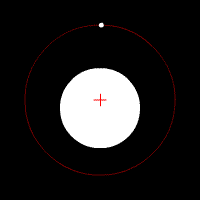I cant make out exactly what your talking about here but
I have noticed a few things that you might need to consider.

from what I can tell so far is
1) you have a large mass (M)
2) a rod that extends from the bottom of mass (M)
3) a rope that extends from the bottom of the rod to mass (m2)
and
4) another mass (m1) that will collide with mass (m2)
I can go ahead and tell you what will happen when
mass (m1) collides with mass (m2)
1) mass (m1) will give energy to (m2)
2) mass (m2) will try to move in the same direction of the
energy or force that (m1) gave to it.
3) mass (m2) is bound to the rod by the rope so it cannot
travel in that direction so it begins to rotate around
the rod and wraps the rope around the rod as it spirals
inward toward the rod.
the torque placed on the rope by (m2) will slightly
twist the rod causing (M) to wobble as (m2) spirals inwards
toward the rod.
you can think of the bottom of the rod moving like the
small mass in the below image and the mass (M) moving
in the same fashion as below also , except there will
most likely also be a rotation of the entire system
that changes with the ever changing direction of forces.

that is what will actually happen if you ever experiment
with it , because that is what physics predicts will happen.
the good part about physics is that the above can be calculated
using a computer program and actual math.




